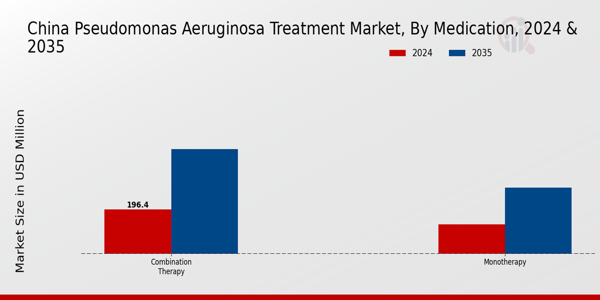China Pseudomonas Aeruginosa Treatment Market Overview
As per MRFR analysis, the China Pseudomonas Aeruginosa Treatment Market Size was estimated at 312 (USD Million) in 2023.The China Pseudomonas Aeruginosa Treatment Market Industry is expected to grow from 326.4(USD Million) in 2024 to 749.9 (USD Million) by 2035. The China Pseudomonas Aeruginosa Treatment Market CAGR (growth rate) is expected to be around 7.855% during the forecast period (2025 - 2035).
Key China Pseudomonas Aeruginosa Treatment Market Trends Highlighted
The China Pseudomonas Aeruginosa Treatment Market is influenced by several key market drivers that are shaping its growth. The increasing incidence of hospital-acquired infections, especially in healthcare settings, continues to be a major driver. The persistent increase in immunocompromised patients due to aging populations and cancer treatments also augments the market need for effective treatment options. In addition, improvements in the healthcare infrastructure and increased investment on China’s healthcare research, specifically on the effects of antibiotics, aids the development of new and advanced therapies targeting infections of Pseudomonas aeruginosa.
The increased concentration towards personalized medicine presents a gap that can be exploited in this market. Patients who have undergone an antibiotic treatment and show resistance need targeted therapies, and these can specifically address the need. This gap enables pharmaceutical industries to expand by providing new therapeutics that may include bacteriophage therapies or other combination antibiotics targeting resistant strains. The rapid evolution of biotechnology companies in China provides additional opportunities for joint ventures for the research and development of alternative treatment approaches.
Recent trends show that many facilities use telephone and mobile health services to manage their patients more effectively, indicating a shift towards telemedicine and digital health solutions for Pseudomonas aeruginosa.
Furthermore, the application of artificial intelligence in diagnostics and treatment planning is beginning to gain traction in Chinese hospitals. With these developments, there is greater focus on constant evaluation of therapy monitoring, thus improving patient outcomes. All these factors combine to make the China Pseudomonas Aeruginosa Treatment Market an influential and rapidly evolving in terms of its public health impact.

China Pseudomonas Aeruginosa Treatment Market Drivers
Increasing Incidence of Pseudomonas Aeruginosa Infections
The growing number of infections caused by Pseudomonas Aeruginosa is a major driver for the China Pseudomonas Aeruginosa Treatment Market Industry. According to the Chinese Center for Disease Control and Prevention, there has been a noted increase in hospital-acquired infections, particularly in patients with compromised immune systems. The statistics reveal that 30% of ventilator-associated pneumonia cases in intensive care units are attributed to Pseudomonas Aeruginosa infections.
This alarming trend necessitates advanced treatments and therapies designed specifically for combating this pathogen, thereby driving growth in the market. As healthcare providers such as China's National Health Commission continue to focus on improving infection control, the demand for effective treatment options will further increase, leading to a broader market for Pseudomonas Aeruginosa therapies.
Government Initiatives for Antimicrobial Resistance
The Chinese government has taken substantial measures to combat antimicrobial resistance, which significantly impacts the China Pseudomonas Aeruginosa Treatment Market Industry. Recently, the Ministry of Health and Family Planning released a national action plan that aims to reduce antibiotic resistance rates by 20% over the next 5 years. Given that Pseudomonas Aeruginosa is known for its multidrug resistance, these initiatives will increase the need for new treatment options that can target resistant strains effectively.
With a focus on Research and Development (R&D) funded by government grants, pharmaceutical companies are encouraged to innovate new drugs that can effectively tackle this challenging pathogen, stimulating market growth.
Rising Healthcare Spending and Research Investments
In recent years, China's healthcare expenditure has significantly risen, reaching 7.2% of the GDP as reported by the National Health Commission of China. This increase is driving investments in innovative treatments for infectious diseases, including Pseudomonas Aeruginosa. The rise in spending translates to a larger market for pharmaceuticals focusing on serious bacterial infections.
Additionally, with increased funding allocated to Research and Development (R&D), companies are exploring advanced therapeutic approaches such as bacteriophage therapy and combination antibiotic strategies.This trend will likely bolster the China Pseudomonas Aeruginosa Treatment Market Industry by paving the way for next-generation treatments that address evolving microbial threats.
China Pseudomonas Aeruginosa Treatment Market Segment Insights
Pseudomonas Aeruginosa Treatment Market Medication Insights
The China Pseudomonas Aeruginosa Treatment Market within the Medication segment is evolving as a critical area of focus within the healthcare landscape, primarily driven by the increasing prevalence of Pseudomonas aeruginosa infections, which are notorious for their resistance to multiple antibiotics. Growing awareness regarding effective treatment methodologies has propelled investments in this sector, as well as significant interest from pharmaceutical companies. Monotherapy, where a single medication is used for treatment, remains a conventional approach, offering simplicity and direct action against the pathogen.
Although it has been utilized historically, this method may face challenges due to emerging antibiotic resistance, leading to inadequate treatment efficacy in some cases. Consequently, Combination Therapy is becoming increasingly important in the fight against Pseudomonas aeruginosa infections. This approach involves using two or more medications concurrently, enhancing treatment effectiveness while minimizing resistance development. In terms of market dynamics in China, Combination Therapy is gaining traction due to its ability to target the infection more comprehensively and provide a broader spectrum of activity against resistant strains.
Such treatment regimens are favored in hospital settings, especially for patients with severe or complicated infections, as the strategy not only offers improved clinical outcomes but also has the potential for reduced hospital stays. Moreover, the healthcare infrastructure in China is progressively adapting to include advanced diagnostic tools and robust antibiotic stewardship programs, which support the increased utilization of both Monotherapy and Combination Therapy approaches tailored to individual patient needs.
Additionally, the regulatory landscape in China is gradually evolving to facilitate faster approvals for innovative treatment solutions, allowing professionals to respond more efficiently to the growing challenge posed by multi-drug resistant organisms. The market in China is further characterized by an increasing collaboration between public health initiatives and private sector involvement, fostering an environment conducive to Research and Development aimed at discovering novel agents for combating Pseudomonas aeruginosa.
All these factors contribute to a dynamic and promising landscape for the China Pseudomonas Aeruginosa Treatment Market in the Medication sector, highlighting the critical roles that both Monotherapy and Combination Therapy strategies play in addressing the urgent public health challenge posed by resistant infections.

Pseudomonas Aeruginosa Treatment Market Route Of Administration Insights
The Route Of Administration segment of the China Pseudomonas Aeruginosa Treatment Market plays a critical role in determining patient outcomes. This market segment includes various administration methods, notably Oral, Intravenous, and Nasal routes. The Intravenous route is particularly significant due to its rapid action and efficacy against severe infections, facilitating immediate therapeutic effects, especially in critically ill patients.
Meanwhile, the Oral route offers ease of administration and is preferred for outpatient management, contributing to increased patient adherence and comfort.The Nasal administration, although less common, provides a non-invasive alternative that can be an essential route in specific patient groups, especially in pediatric populations.
The dynamics of the China Pseudomonas Aeruginosa Treatment Market segmentation reflect the country's growing healthcare infrastructure and increased focus on developing effective treatment protocols against antibiotic-resistant infections. As healthcare policies in China advance and research evolves, there is a continuous push to innovate and expand the available treatment options, addressing the diverse needs of the patient population while aiming to improve overall healthcare outcomes.Overall, understanding the nuances of each Route Of Administration is crucial for stakeholders looking to enhance therapeutic strategies and patient care in this challenging therapeutic landscape.
Pseudomonas Aeruginosa Treatment Market Distribution Channel Insights
The Distribution Channel segment of the China Pseudomonas Aeruginosa Treatment Market plays a crucial role in ensuring accessibility and availability of treatment options for patients. Hospital pharmacies are integral as they cater directly to hospitalized patients, often offering tailored medication regimens that suit individual cases. The growing number of hospitals and healthcare facilities in China contributes to the importance of this channel.
Retail pharmacies also play a vital role in the distribution of medications, serving as the frontline for patients seeking treatment for common infections.The convenience and localized nature of retail pharmacies allow them to effectively reach a broad consumer base.
Online pharmacies have emerged as a significant channel, especially post the COVID-19 pandemic, as they offer ease of access and home delivery services, improving patient adherence to treatment plans. This channel's growth is supported by increasing internet penetration and a shift toward digital healthcare solutions in China. Each of these channels serve to enhance the overall accessibility and efficiency of treatment delivery, influencing the overall dynamics of the China Pseudomonas Aeruginosa Treatment Market significantly.
China Pseudomonas Aeruginosa Treatment Market Key Players and Competitive Insights
The China Pseudomonas Aeruginosa Treatment Market is experiencing significant competitive dynamics driven by a surge in antibiotic-resistant infections and a growing awareness of the deteriorating situation regarding bacterial resistance. This market represents considerable potential as the healthcare sector in China expands and becomes more focused on infection control and patient management. A variety of pharmaceutical companies are strategically positioning themselves to capture share in this segment, emphasizing innovative treatments and novel drug delivery systems tailored to combat Pseudomonas Aeruginosa, which is known for having a high resistance rate to many conventional treatments.
Increasing investment in research and development is evident as companies strive to introduce new therapies with proven efficacy, fostering intense competition among market players.Pfizer has established a formidable presence in the China Pseudomonas Aeruginosa Treatment Market, leveraging its extensive research capabilities and a robust portfolio of antibiotic treatments. The company benefits from its well-recognized brand, significant resources allocated to R&D, and a strong sales network that facilitates distribution across the region.
Pfizer's strengths lie in its commitment to developing novel solutions that address the unique challenges of treating multi-drug resistant bacteria. With a focus on adhering to regulatory standards and engaging in collaborations with local healthcare institutions, Pfizer effectively navigates the competitive landscape while also fostering educational initiatives aimed at promoting appropriate antibiotic usage and awareness of Pseudomonas Aeruginosa infections.Sandoz is another key player in the China Pseudomonas Aeruginosa Treatment Market, known for its focus on high-quality generic and biosimilar medicines.
The company has strategically positioned itself by providing affordable treatment options for a wide range of infections, including those caused by Pseudomonas Aeruginosa. Sandoz's strengths include its extensive product range, which encompasses both antibiotic therapies and support medications that are critical for effective treatment. The company has been involved in various mergers and acquisitions that enhance its market presence and expand its capabilities in innovative therapies.
Sandoz's endeavor to ensure the availability of essential drugs in the Chinese market, combined with its emphasis on improving patient access to effective treatments, contributes to its strong competitive standing and aligns with the overall trend of addressing the challenges posed by antibiotic resistance in the region.
Key Companies in the China Pseudomonas Aeruginosa Treatment Market Include:
China Pseudomonas Aeruginosa Treatment Market Industry Developments
The China Pseudomonas Aeruginosa Treatment Market has recently seen significant developments, especially in the wake of increasing antibiotic resistance. Companies such as Pfizer, Merck, and GSK are focusing on Research and Development to enhance treatment options. Reports suggest that Pfizer has launched a comprehensive initiative this year to address multi-drug resistant infections, which is crucial given the rising prevalence of Pseudomonas Aeruginosa in healthcare settings across China.
Additionally, in August 2023, AbbVie announced a strategic partnership with a local biotech firm aimed at accelerating the development of innovative therapies targeting antibiotic-resistant infections. Merger and acquisition activity also marked the market, with Novartis acquiring a promising biotech company in July 2023 to bolster its pipeline in anti-infective solutions.
The growth of the market is reflected in increased investments in healthcare infrastructure by the Chinese government, which aims to improve treatment outcomes for patients suffering from severe infections. Over the past two years, AstraZeneca has expanded its research footprint in China, contributing to advancements in Pseudomonas Aeruginosa treatment protocols, demonstrating the robust dynamics of this market sector in the region.
China Pseudomonas Aeruginosa Treatment Market Segmentation Insights
Pseudomonas Aeruginosa Treatment Market Medication Outlook
Pseudomonas Aeruginosa Treatment Market Route Of Administration Outlook
Pseudomonas Aeruginosa Treatment Market Distribution Channel Outlook
-
Hospital Pharmacies
-
Retail Pharmacies
| Report Attribute/Metric Source: |
Details |
| MARKET SIZE 2023 |
312.0(USD Million) |
| MARKET SIZE 2024 |
326.4(USD Million) |
| MARKET SIZE 2035 |
749.9(USD Million) |
| COMPOUND ANNUAL GROWTH RATE (CAGR) |
7.855% (2025 - 2035) |
| REPORT COVERAGE |
Revenue Forecast, Competitive Landscape, Growth Factors, and Trends |
| BASE YEAR |
2024 |
| MARKET FORECAST PERIOD |
2025 - 2035 |
| HISTORICAL DATA |
2019 - 2024 |
| MARKET FORECAST UNITS |
USD Million |
| KEY COMPANIES PROFILED |
Pfizer, Sandoz, Teva, Amgen, Mylan, Merck, Bayer, AstraZeneca, Roche, GSK, Eli Lilly, AbbVie, Sanofi, Novartis, Bristol Myers Squibb |
| SEGMENTS COVERED |
Medication, Route Of Administration, Distribution Channel |
| KEY MARKET OPPORTUNITIES |
Rising incidence of hospital-acquired infections, Increasing demand for novel antibiotics, Expansion of healthcare infrastructure, Growing awareness of infection control, Increased investment in R&D initiatives |
| KEY MARKET DYNAMICS |
rising infection rates, increasing antibiotic resistance, expanding healthcare infrastructure, growing research and development, heightened awareness of treatments |
| COUNTRIES COVERED |
China |
Frequently Asked Questions (FAQ):
In 2024, the China Pseudomonas Aeruginosa Treatment Market is expected to be valued at 326.4 million USD.
By 2035, the market is projected to reach a valuation of 749.9 million USD.
The market is expected to exhibit a CAGR of 7.855 percent during the period from 2025 to 2035.
Key players in the market include Pfizer, Sandoz, Teva, Amgen, and Merck, among others.
Monotherapy for Pseudomonas Aeruginosa is valued at 130.0 million USD in 2024.
Combination Therapy is valued at 196.4 million USD in 2024.
In 2035, the market size for Monotherapy is expected to increase to 290.0 million USD.
The expected market value for Combination Therapy by 2035 is 459.9 million USD.
Emerging trends include advancements in antibiotic development and a growing focus on combination therapies.
Challenges include antibiotic resistance and the high cost of research and development.
















